Medical alert systems have evolved since the American International Telephone Corporation created the first medical alert pendant in 1974. (1) This device contacted a list of preprogrammed phone numbers when the user pushed the button during an emergency. Today, the best medical alert systems include 24/7 professional monitoring, fall detection, and GPS tracking, with many offering health and wellness features like heart rate monitoring, step tracking, and medication reminders.
Medical alert watches are some of the most advanced devices in the industry. Most medical alert companies offer similar smartwatches, but the UnaliWear Kanega Watch’s unique fall detection technology and design help it stand out.
Why we like UnaliWear Kanega Watch medical alert system
The UnaliWear Kanega Watch is the only medical alert system available from UnaliWear. Its patented fall detection is based on real users’ falls and continues to improve the more you wear it. The Kanega Watch connects to the 24/7 monitoring center anywhere with cell service or Wi-Fi connection, so you can wear it at home and on the go. Our testers liked the personable onboarding experience and were impressed with the watch’s overall performance.
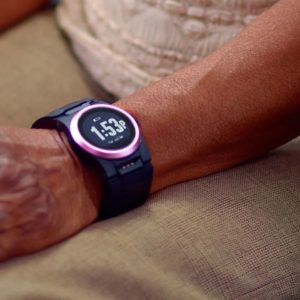

Key product features
What you should know
The UnaliWear Kanega Watch is a medical alert watch that works anywhere with cellular service or a Wi-Fi connection. The watch’s dynamic fall detection sensors learn what is and isn’t a fall based on your past movements and other users’ real falls. Fall detection sensitivity can be adjusted to suit your activity level and needs.
- Since we adjusted our fall detection sensitivity and testing method to mimic more realistic falls, the Kanega Watch detected 100% of test falls.
- At $79.95 per month plus a $299 setup and equipment fee, the Kanega Watch is one of the most expensive medical alert systems we’ve tested. Some may think the proprietary fall detection technology and watch design are worth the price, while others may want a more affordable option.
- We recommend the UnaliWear Kanega Watch for older adults or anyone at high risk of falls looking for a nontraditional fall detection device.
- Our tester thought the watch was bulky, but they were used to wearing it by the second day. Users with smaller wrists or dexterity issues may find the watch uncomfortable.
- There’s no caregiver app, but you can add medication reminders and emergency contact information in an online caregiver portal.
UnaliWear Kanega Watch overview
The UnaliWear Kanega Watch is a medical alert watch that connects to a 24/7 monitoring center during an emergency. Wearers can contact the monitoring center by pressing a button, using their voice, or triggering fall detection.
Unlike most fall detection devices, the watch’s sensors actively learn your movements to detect what is and isn’t a fall. Check out our RealFall™ section below to learn more about UnaliWear’s machine-learning fall detection technology.
The watch has a two-way speaker that allows you to speak with the monitoring center agent and use simple verbal commands. For example, you can call the monitoring center, ask for the time, and learn the date by saying the wake word “Fred Astaire,” followed by the appropriate command.
Specs
| Monthly cost | $79.95 |
| Trial period | 30 days |
| Fall detection | Yes, included for free |
| Average response time | 60+ seconds |
| Connectivity | Verizon cellular, GPS, Wi-Fi |
| App | N/A |
| Additional accessories | N/A |
Setting up the Kanega Watch
All Kanega Watches arrive ready to use and require minimal setup. Our printed instructions included content and graphics explaining how to charge the watch batteries. The watch comes with four custom lithium-ion batteries and uses two that snap into the wristband. This thoughtful design means you never have to remove the watch to charge it—once the two batteries are low, you replace them with the other two fully charged batteries.
Our testers received an email with onboarding information and helpful links to UnaliWear’s tutorial videos. We struggled with correctly adjusting and fitting the watchband, especially since the watch is heavy and difficult to put on your wrist without assistance. We eventually found a video on how to adjust the watchband, but we wish there were instructions in the user guide, too, since adjusting and wearing the watch is one of the first things users will do.
“I was the main tester for the UnaliWear Kanega Watch, so I had an onboarding call with a customer service representative. The representative walked me through the watch’s basic functions and the user guide and offered to answer any questions. He was friendly and helpful, and I believe users—especially older adults—will appreciate this personable touch.”
Emily Breaux, product tester and writer
The watch’s speaker volume was low during our first few test calls to the monitoring center, making it difficult to hear the agent. Our tester tried to adjust the volume themselves, but the watch directed them to call customer service or watch a video tutorial to learn how to adjust the speaker volume.
Some users may prefer calling customer service to adjust the volume instead of doing it themselves, while more hands-on users may be frustrated that they need to watch a video or make a call to adjust a simple setting.
Calling the monitoring center
We conducted our first calls to the monitoring center by pressing the “Crown” button on the side of the watch face.
Our testers liked that the watch verbally walks you through each step of calling the monitoring center by stating, “I think I heard you call for help. I am contacting the operator. Press the Crown button once if you do not need help, and I will cancel the call. I am connecting you to the monitoring center. I’m still working on connecting you to the operator. Call connected.”
These step-by-step announcements can reassure someone during an emergency, especially after a fall.
Sometimes, the wake word “Fred Astaire” plus the commands “Get help” or “Call the operator” worked after our first attempt, but other times, we had to repeat the wake word and command multiple times to prompt the watch and call the monitoring center.
Fall detection performance
You can adjust the watch’s fall detection sensitivity by calling customer service. The default sensitivity setting is 50, which is right in the middle. The least sensitive setting is 100, and the most sensitive setting is 0.
We like that you can adjust the sensitivity setting to fit your lifestyle. For example, more active users who play tennis or other intensive activities may request a setting above 50. Less active users or those at higher risk of falling may choose a more sensitive fall detection setting.
We first tried using our standard fast, hard fall testing method—dropping the watch from shoulder height—but the representative let us know the watch doesn’t detect falls if not on the wrist. One tester did have an experience that contradicted this: When they wore the watch while showering, it fell off their wrist and initiated an emergency call.
Our testers adjusted our test fall methods to sideways and backward falls after a customer service representative told us the watch’s sensors better detect these types of falls. After adjusting our testing method, the watch detected 100% of our falls.
Wearing the watch
Our main tester wore the watch for a couple of days. They thought it was bulky and heavy on the first day but adjusted to the fit by the second day. Those with small, thin wrists may find it difficult to wear the watch at all times.
“I didn’t sleep with the watch since it is so bulky and uncomfortable, even though it’s designed to keep on at all times. I was afraid I would hit my head when adjusting sleeping positions.”
Product tester
Caregiver online portal
The Kanega Watch doesn’t have a caregiver app, but it does have an online portal. Our testers were confused as to why the setup guide and online tutorial videos didn’t include information about the portal. To learn how to access the portal, our testers spoke with a customer service representative, who sent them a portal login link.
The online portal has limited features, including:
- Adding and editing emergency contacts
- Managing up to seven Wi-Fi networks the watch can connect to
- Setting five daily medication reminders
Caregivers can’t view the watch’s GPS location in the online portal, although monitoring center agents can access the device’s location during an emergency call.
We tested the medication reminder feature but found it unhelpful and vague. The watch vibrated, and then the screen displayed a question mark and “Press Crown Button to Continue.” Once our tester pressed the crown button, the screen displayed “Take Meds.”
These reminders may not be helpful if you or your loved one take multiple medications with specific dosages.
What customers are saying
UnaliWear is accredited by the Better Business Bureau (BBB). It has an A+ and 4.27- out of 5-star rating based on 82 reviews. Many positive reviews mention the brand’s excellent customer service and how the Kanega Watch is a great alternative to traditional medical alert pendants. Reviewers are pleased with the discreet design and the fact that it looks like a regular smartwatch.
Reviewer Cynthia L. said she researched and picked out the watch with her dad. “He did not like the other fall alert systems he had used. He loves the look and feel of the watch,” she said.
Other reviewers expressed peace of mind while wearing the watch and reported successfully contacting the monitoring center after a fall or test call.
“I am 80 years old and quite active. I had no interest in a pendant and didn’t want or need all the features of an Apple Watch. The Kanega Watch is perfect! I can wear it everywhere, all the time, and feel protected and safe, even in the shower. I’ve only fallen once (so far!), and it worked. I didn’t need help from the agent who spoke to me through my watch, but it was a great test! I called through the watch to an agent to contact my neighbor for help, and it worked perfectly. So happy I have this watch. Highly recommend it, and the company/service”
Cynthia A., BBB Reviewer
Negative reviews mention issues canceling the subscription, the watch being too bulky and falling off, batteries not working correctly, and trouble contacting customer service. As of writing, the company has responded to all negative reviews.
UnaliWear has a 4- out of 5-star rating on Trustpilot based on 15 reviews as of writing. Customers like that the watch works straight out of the box and report it’s easy to use. Many reviewers are pleased that they don’t have to take off the watch to charge it, and others report that fall detection worked properly during an emergency.
“[…] I wear it 24 hours a day, shower, and bathe with it on. Customers are supported by UnaliWear’s ‘Customer Success Team’ with a one-on-one phone consultation with a team member who helped me to create my personalized monitoring center account with my emergency and care contact list, input medication reminders, make sure my watch is functioning correctly, and answer any questions. This is by far the best medical alert device out there. I am genuinely grateful for the UnaliWear Kanega Watch. The peace of mind it brings to me and my family is invaluable.”
Marilyn K., Trustpilot Reviewer
As of this writing, there are only three negative reviews on Trustpilot. One customer mentioned that the watch and batteries were too complicated for their mother, while others had issues returning the equipment.
How does the Unaliwear Kanega Watch work?
The UnaliWear Kanega Watch is a medical alert watch that connects to a 24/7 monitoring center. It uses Verizon cellular service and Wi-Fi (depending on the strongest signal) to call the monitoring center. This dual connection allows you to contact help from nearly anywhere.
How to call the monitoring center
You’ll call the monitoring center by pressing the help button, using voice activation (“Fred Astaire, call for help”), or triggering fall detection. Depending on the situation, a monitoring center agent communicates with you through the watch’s two-way speaker and sends emergency responders or a loved one to your location.
If you’re unresponsive or unable to speak during an emergency call, the agent first calls your primary emergency contact to see if they can check on you. If the emergency contact doesn’t answer or can’t check on you, the agent dispatches emergency responders to your location.
One study found that alerts to caregivers after a fall are a major deciding factor when using a fall detection device. Study participants expect the device to send real-time notifications to caregivers or family members after a fall happens. (2)
How to navigate the watch
Like most medical alert watches, the Kanega Watch operates independently and doesn’t require a smartphone. We also like the fact that it doesn’t have a touchscreen. You can control your Kanega Watch using the Crown button on the side of the watch or your voice.
Research shows older adults may use touchscreens less accurately and more slowly, making touchscreen devices more difficult to navigate. (3)
How to charge and change batteries
Because falls and medical emergencies are unpredictable and can happen at any time, the Kanega Watch is designed to be worn at all times. You don’t even have to take it off to charge it.
The watch includes four rechargeable batteries. Two batteries snap into the watch wristband while the other two charge. When the wristband batteries are low, the watch screen displays “Change batteries.” You’ll remove the two batteries from the wristband and replace them with two fully charged batteries.
The battery charging dock uses light cues to indicate when batteries are fully charged. When charged, the light under the battery turns from red to green.
RealFall™ fall detection technology
The Kanega Watch’s RealFall™ fall detection technology is one of its most unique and impressive features. The fall detection algorithm is based on real Kanega Watch users’ falls and continues to learn and improve over time. (4)
RealFall™ learns your everyday movements that may trigger false alarms. Instead of continuing to incorrectly detect that a repeated, specific movement is a fall, it learns that it’s not. After certain movements, the watch screen displays, “Is this a fall?” and prompts you to answer yes or no.
Many fall detection sensors are static, but the Kanega Watch’s sensors periodically update based on user fall data.
We’ve featured the UnaliWear Kanega Watch in:
Who UnaliWear Kanega Watch is recommended for:
We offer advice to help you decide if the Kanega Watch is right for you or your loved one. Our recommendations should be used as guidance, but ultimately, you’ll know the best medical alert system to meet your needs, preferences, and budget. (5)
- Those with a history of falls or a high risk of falls: We recommend the Kanega Watch’s machine-learning fall detection if you’re at risk of falling due to mobility or gait issues, a history of falls, poor vision, or taking four or more medications. (6)
- Older adults with an active lifestyle: Older adults who drive independently and are active outside the home may feel more confident and secure knowing help is available anytime with a button. (7)
- Anyone preferring a wrist-worn medical alert system: Some users may hesitate to wear a traditional, more obvious medical alert necklace. They may prefer the Kanega Watch’s discreet smartwatch design and find it less intrusive than a necklace.
- Non-tech savvy users: Despite looking like a smartwatch, the Kanega Watch only has a few simple features. Users don’t have to worry about navigating a touchscreen—they either use their voice or press the button on the side of the watch face to operate it.
Most people associate medical alert systems with medical emergencies, but you can contact the monitoring center for medical and non-medical emergencies, such as a fire, home intrusion, or being locked out of your home.
Who UnaliWear Kanega Watch is not recommended for:
- Families on a budget: Although fall detection is included with the monthly fee, paying nearly $80 per month for a medical alert system may not be reasonable for many people’s budgets.
- Those only needing monitoring at home: If you or your loved one is accompanied by a caregiver whenever leaving the house, we recommend choosing a more affordable at-home medical alert system for monitoring in and around the home.
- People with dexterity issues: The Kanega Watch’s unique swappable battery system allows you to always wear the watch, but this design makes it bulkier and heavier than a standard watch. Those with limited dexterity or arthritis may have trouble adjusting the watch band or switching out the small batteries.
- Caregivers who need to track their loved one’s location: Caregivers can’t track the watch’s location. If your loved one is prone to wandering due to dementia or Alzheimer’s (8), we recommend a medical alert system with GPS tracking you can access at all times.
How we rated the UnaliWear Kanega Watch
Our team has tested and used each medical alert system we review. We document our entire testing experience, from setting up the device to troubleshooting issues, testing fall detection, and recording monitoring center response time.
Here’s how we scored the Kanega Watch in the following categories:
Read our full medical alert system testing methodology to learn more about our scoring process.
Warranties and policies
You can purchase the UnaliWear Kanega Watch online or by calling 888-343-1513.
Shipping
Standard shipping (five to seven business days) is free, but there’s a fee for express shipping. The following costs are based on our testing lab location when we ordered the watch, but express shipping costs may vary based on your location:
- Two business days: $56.18
- Overnight shipping: $113.72
Trial period and return policy
If you return your equipment undamaged during UnaliWear’s 30-day trial period, which runs from the date the equipment is shipped to when it’s returned, you’ll receive a full refund.
You don’t have to pay for return shipping when you return your watch and batteries within the 30-day trial period. UnaliWear sends a return shipping label once you cancel your subscription. You’ll receive a full refund if you cancel within the trial period, but you’ll have to pay a $75 restocking fee.
You can still cancel your subscription after the 30-day trial period. If you have a monthly subscription, UnaliWear cancels your monthly fee once the company receives your equipment. Annual subscribers receive a prorated refund for the service months they didn’t use. You won’t pay the $75 restocking fee if you cancel after the 30-day trial period.
Warranty
The watch includes a lifetime warranty covering manufacturing defects and performance issues. UnaliWear provides one free replacement if you break the watch but charges $199 for any additional breaks. You must pay for shipping for all replacements.
UnaliWear vs. competitors
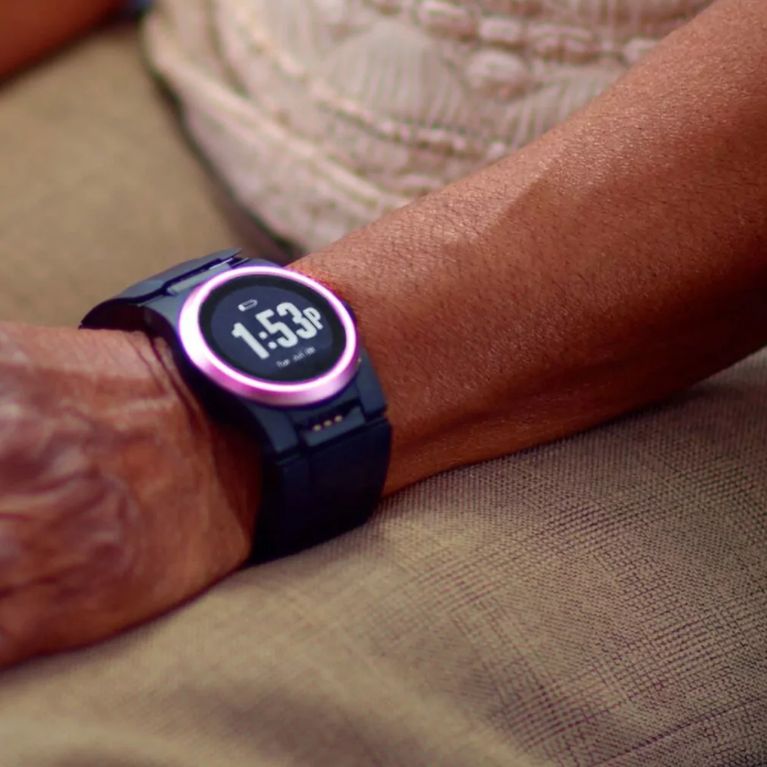
|
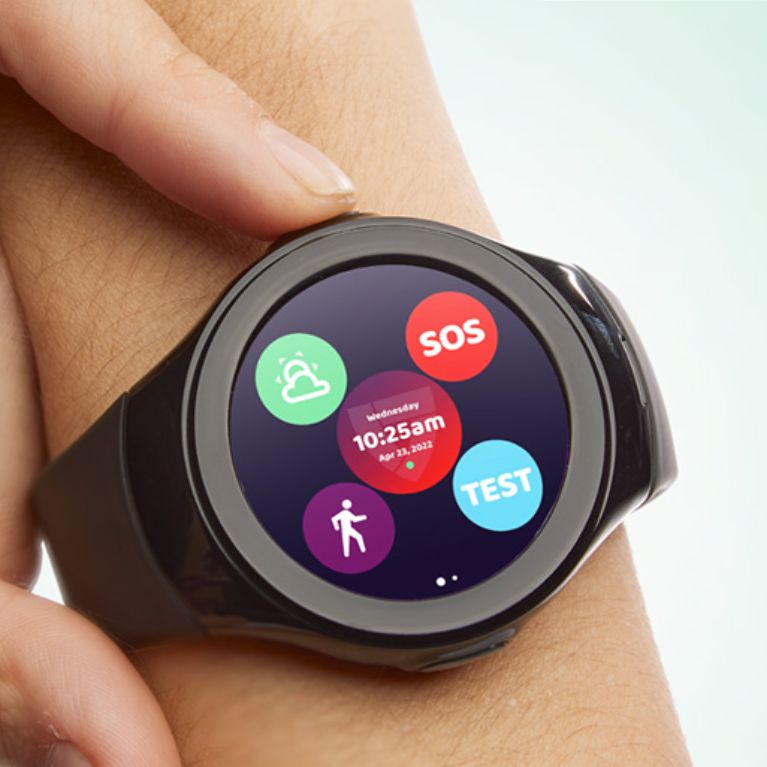
|
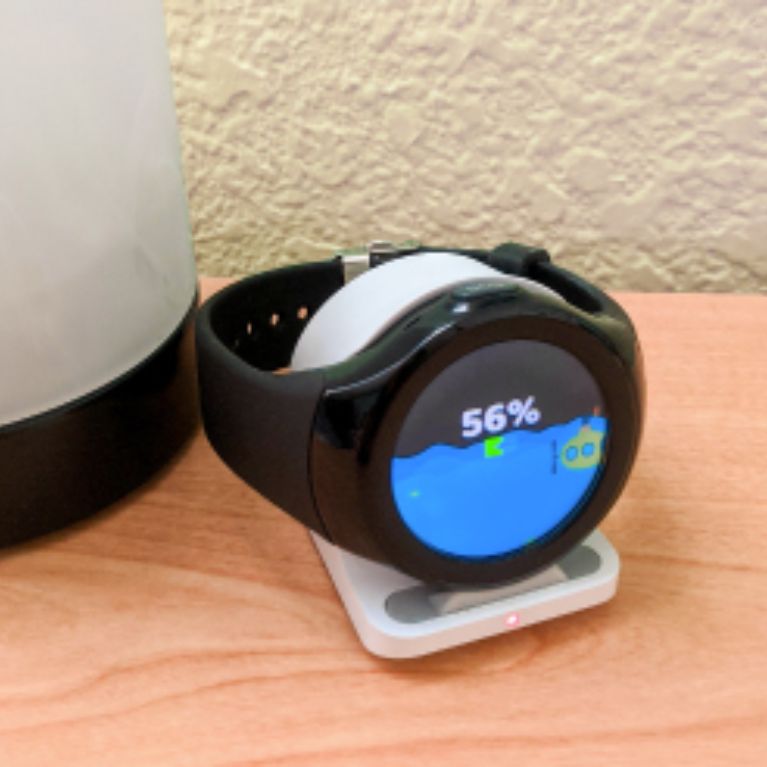
|
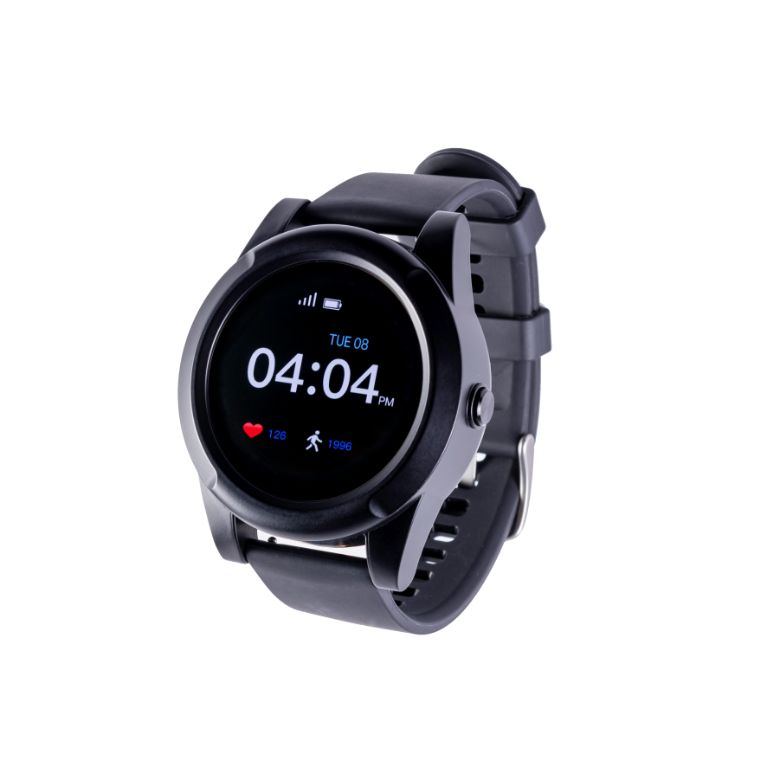
|
|
| UnaliWear Kanega Watch | Medical Guardian MGMove | Bay Alarm Medical SOS Smartwatch | LifeFone Safe Watch Active | |
| Rating | ||||
| Monthly price | $79.95 | $39.95 | $39.95 | $47.95 |
| Equipment fee | $299 | $199.95 | $179 | $0 |
| Fall detection | Free | $10/month | $10/month | $5/month |
| Battery life | 24 to 36 hours | 24 hours | 6 to 12 hours | 24 hours |
| GPS tracking | Yes | Yes | Yes | Yes |
| Caregiver app | No | Yes | Yes | No |
The above medical alert watches have lower monthly and equipment fees than the Kanega Watch. Even if you add fall detection to each watch, their monthly fee is still less than UnaliWear’s $79.95. Unlike the Kanega Watch, you must remove the MGMove, SOS Smartwatch, and LifeFone Safe Watch Active to recharge it.
Medical Guardian MGMove includes a free caregiver app, GPS location tracking, step tracking, and a weather app. Messaging and reminder features are available for an additional $5 per month. Users can send voice-to-text messages to designated caregivers directly from their watch.
Bay Alarm Medical SOS Smartwatch also includes a free caregiver app, location tracking, step tracking, and a weather app. The MGMove and SOS Smartwatch are much lighter and sleeker than the Kanega Watch. LifeFone Safe Watch Active doesn’t have an app, but caregivers can view the user’s location with a text and receive the watch’s live Google Maps location. The Safe Watch Active also has a heart rate monitor, step tracking, and a weather app.
FAQs
What is the UnaliWear Kanega Watch?
The UnaliWear Kanega Watch is a medical alert watch that connects to a 24/7 monitoring center during an emergency. It includes fall detection sensors that learn your movements to decrease false alarms. You can contact the monitoring center by pressing a button, using voice activation, or triggering fall detection. A monitoring center agent speaks with you through the watch’s two-way speaker and dispatches emergency services to your location if needed.
What is the cost of the UnaliWear Kanega Watch?
The UnaliWear Kenga Watch costs $79.95 per month with a $299 equipment fee if you choose a monthly subscription or $779.40 per year plus the $299 equipment fee for an annual subscription. Fall detection is included for free.
How long do UnaliWear Kanega Watch batteries last?
UnaliWear Kanega Watch batteries last 24 to 36 hours. Unlike most medical alert watches, you don’t remove the watch to recharge it. The watch includes four rechargeable batteries but only uses two at a time. These batteries attach to the watch band. When wearing your Kanega Watch, the band holds two batteries while the others charge. Once the batteries are low, you’ll replace them with the two fully charged batteries and charge the other two.
Is the UnaliWear Kanega Watch waterproof?
Yes, the UnaliWear Kanega Watch is waterproof. You can wear it in the shower, when bathing, washing your hands, exercising, and more. It has an IP67 rating, meaning it can be submerged in at least 3 feet of water for about 30 minutes. (9) Being able to wear the watch while showering or bathing is crucial—research shows that falling in the bathroom is more than twice as likely to result in injury than falls in the living room. (10)
Our experts
Anju Goel, M.D., MPH
Anju Goel, M.D., MPH, is a public health consultant and physician in California with a focus on communicable diseases, health policy, health promotion, and disaster preparedness. She’s also a consultant for the Centers for Disease Control and Prevention (CDC) on the COVID-19 response. Dr. Goel received her medical degree from Stanford University School of Medicine and her Master of Public Health from Columbia University Mailman School of Public Health. She’s board-certified by the American Board of Internal Medicine.
Krista Manning
Krista Manning is an accomplished medical copy editor and fact-checker who stands out in the pharmaceutical, health, and wellness domains. With a meticulous eye for detail and a command of medical language, Krista ensures the accuracy and clarity of content. Beyond her professional expertise, Krista is an advocate for mental health awareness. Recognizing the crucial intersection of psychological and physical well-being, she actively contributes to projects that promote mental health awareness within the healthcare narrative. Krista’s commitment extends beyond the pages she edits, emphasizing the holistic nature of health communication.

Emily Breaux
Fortune Recommends Sr. Staff Writer
About Author
Emily is a health and wellness writer with a background in marketing and secondary education. She enjoys covering wellness topics that help readers navigate aging, caregiving, sleep, and nutritional health. Emily specializes in medical alert systems and has hand-tested more than 20 devices. Her work has been featured in National Council on Aging, HelpGuide, AgingInPlace.org, and MarketWatch.
Emily is based in New Orleans and enjoys neighborhood walks, practicing yoga, performing in local theatre productions, and finding her next read at the library.
